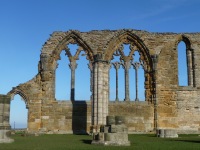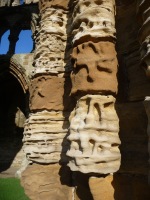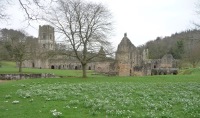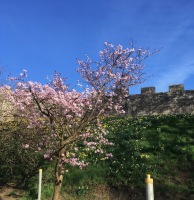PZG - feasting
Jul. 3rd, 2017 09:18 pmThis was the first PZG (professional zooarchaeology group) meeting since my move to Sweden last summer, and I really enjoyed seeing my ex-colleagues again. The meeting was held in Cardiff, where I had never been before, unless you count changing from train to regional bus for a living history event a few years ago. The city centre is fairly compact and can (as evidenced) be seen in two hours, including a visit to the castle, but excluding the art and natural history museum. I can recommend a visit to the castle, not for the actual remains of the Norman castle, which is probably only exciting if you're really into Norman castles or never seen one before, but for the 19th century rooms. They were described as state rooms for the marquesses of Bute, and I went in perfunctory, seeing as I had after all paid for it. But wow! This was not some generic 'seen one, seen them all' fancy rooms for nobles to impress other nobles, but rooms done in total neo-gothic style! I particularly liked the library and the so called Arab room.
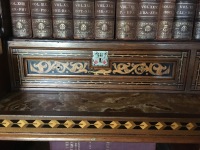
Intarsia details from a bookshelf in the library. Click to embiggen.
The actual meeting was in two parts: first several short talks on bone assemblages from feasting - or possibly not feasting! - and then a lunch break at a nice pub nearby. Somewhat of a student pub rather than "traditional", but they served good food and had a beer garden, so no complaints from me.
The talks discussed how to define "feasting", apparently an impossibility if you want to have a definition that can be useful in archaeology. As with all human activities, there are A LOT of variations and exceptions to rules. For example, one feasting definition includes food waste remains from animals not normally eaten to be one marker of "special" meals, but then, how do you exclude animals eaten in times of starvation when you can't be too picky about where your protein comes from? Also, if you define feasting too vaguely, it becomes too all-encompassing and therefore useless in regards to archaeology.
The talks also included two new PhD students talking about their research: Bettina Stolle from Stockholm on late Iron Age/Viking Age ritual-profane deposits, and Thomas Fowler from Nottingham on rabbits and hare. The latter is part of the Easter E.G. project, and will discuss introduction of brown hare and rabbit to Britain as well as distinguishing between brown hare and mountain hare.
We also had an interesting case study from Scotland, where it really goes into what I label "weird shit": a pit with a cattle skull + mandibles and three articulated cattle feet but with the final toe bones missing. As they excavated they found that the fourth cattle foot had been wedged into the cattle's mouth, possibly inserted from the back of the throat rather than from the mouth. No-one in the meeting had ever heard of something similar, so who knows what the reasoning was behind this action? Weird shit indeed.
The final morning thing was an outreach/creativity session. I really liked the creativity idea - useful for people who say they aren't creative, as it really forces you to think outside the box. The idea? One minute to come up with "101 uses for a dead rabbit" - luckily it's a magical rabbit, as after you've done one thing to it, it becomes whole again. We came up with: (several version of) food, lucky rabbit foot, draught excluder, hand puppet, fur hood, selling the bones as fashion accessories to hipsters, including it in a skeleton reference collection (of course!), reference data for Thomas (see above), and several other things I can't remember. We got far less than 101 uses though.
The afternoon session focussed on practical bone and antler working. Some of us leapt with great pleasure on 'making an antler ring' (the Cardiff archaeologists have done that as an outreach thing on several music festivals), and others, myself included, looked at tools and replica objects and talked to the two craftsmen -one an archaeological illustrator with this as a hobby, and the other a MSc student. It's always good to get some practical feedback on things. For example, many articles claim that antler was soaked in water before working as that renders it soft and pliable. The craftsmen said that a little spit was enough - if you soaked the antler the collagen became so soft that it became impossible to carve; just got the blade all gunky. Another thing I learnt was that it's not necessary to fill ring and dot-motifs or other carvings with tar or resins to colour them, just skin oil + dirt from normal use will do that very quickly.
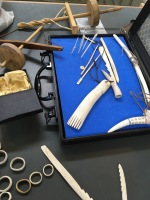
Hand drills and replicas of antler artefacts. Click to embiggen.
After the meeting my holiday continued: I visited a friend outside Cardiff, and then four days in London for research and touristing (unfortunately coinciding with a 30°C heatwave - at least the British Library was cool), and then a weeked of dancing at the Oxford Lindy Exchange (probably the best dance exchange in the UK, not that I'm biased or anything :-) ).

Intarsia details from a bookshelf in the library. Click to embiggen.
The actual meeting was in two parts: first several short talks on bone assemblages from feasting - or possibly not feasting! - and then a lunch break at a nice pub nearby. Somewhat of a student pub rather than "traditional", but they served good food and had a beer garden, so no complaints from me.
The talks discussed how to define "feasting", apparently an impossibility if you want to have a definition that can be useful in archaeology. As with all human activities, there are A LOT of variations and exceptions to rules. For example, one feasting definition includes food waste remains from animals not normally eaten to be one marker of "special" meals, but then, how do you exclude animals eaten in times of starvation when you can't be too picky about where your protein comes from? Also, if you define feasting too vaguely, it becomes too all-encompassing and therefore useless in regards to archaeology.
The talks also included two new PhD students talking about their research: Bettina Stolle from Stockholm on late Iron Age/Viking Age ritual-profane deposits, and Thomas Fowler from Nottingham on rabbits and hare. The latter is part of the Easter E.G. project, and will discuss introduction of brown hare and rabbit to Britain as well as distinguishing between brown hare and mountain hare.
We also had an interesting case study from Scotland, where it really goes into what I label "weird shit": a pit with a cattle skull + mandibles and three articulated cattle feet but with the final toe bones missing. As they excavated they found that the fourth cattle foot had been wedged into the cattle's mouth, possibly inserted from the back of the throat rather than from the mouth. No-one in the meeting had ever heard of something similar, so who knows what the reasoning was behind this action? Weird shit indeed.
The final morning thing was an outreach/creativity session. I really liked the creativity idea - useful for people who say they aren't creative, as it really forces you to think outside the box. The idea? One minute to come up with "101 uses for a dead rabbit" - luckily it's a magical rabbit, as after you've done one thing to it, it becomes whole again. We came up with: (several version of) food, lucky rabbit foot, draught excluder, hand puppet, fur hood, selling the bones as fashion accessories to hipsters, including it in a skeleton reference collection (of course!), reference data for Thomas (see above), and several other things I can't remember. We got far less than 101 uses though.
The afternoon session focussed on practical bone and antler working. Some of us leapt with great pleasure on 'making an antler ring' (the Cardiff archaeologists have done that as an outreach thing on several music festivals), and others, myself included, looked at tools and replica objects and talked to the two craftsmen -one an archaeological illustrator with this as a hobby, and the other a MSc student. It's always good to get some practical feedback on things. For example, many articles claim that antler was soaked in water before working as that renders it soft and pliable. The craftsmen said that a little spit was enough - if you soaked the antler the collagen became so soft that it became impossible to carve; just got the blade all gunky. Another thing I learnt was that it's not necessary to fill ring and dot-motifs or other carvings with tar or resins to colour them, just skin oil + dirt from normal use will do that very quickly.

Hand drills and replicas of antler artefacts. Click to embiggen.
After the meeting my holiday continued: I visited a friend outside Cardiff, and then four days in London for research and touristing (unfortunately coinciding with a 30°C heatwave - at least the British Library was cool), and then a weeked of dancing at the Oxford Lindy Exchange (probably the best dance exchange in the UK, not that I'm biased or anything :-) ).

